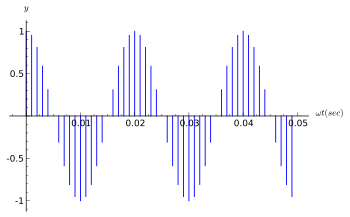Digital signal (signal processing)


In the context of digital signal processing (DSP), a digital signal is a discrete-time signal for which not only the time but also the amplitude has discrete values; in other words, its samples take on only values from a discrete set (a countable set that can be mapped one-to-one to a subset of integers). If that discrete set is finite, the discrete values can be represented with digital words of a finite width. Most commonly, these discrete values are represented as fixed-point words (either proportional to the waveform values or companded) or floating-point words.[1][2][3][4][5]

The process of analog-to-digital conversion produces a digital signal.[6] The conversion process can be thought of as occurring in two steps:
- sampling, which produces a continuous-valued discrete-time signal, and
- quantization, which replaces each sample value by an approximation selected from a given discrete set (for example by truncating or rounding).
It can be shown that for signal frequencies strictly below the Nyquist limit that the original continuous-valued continuous-time signal can be almost perfectly reconstructed, down to the (often very low) limit set by the quantisation.
Common practical digital signals are represented as 8-bit (256 levels), 16-bit (65,536 levels), 24-bit (16.8 million levels) and 32-bit (4.3 billion levels). But the number of quantization levels is not necessarily limited to powers of two.
References
- ↑ Smith, Steven W. (2002-11-06). "3". Digital Signal Processing: A Practical Guide for Engineers and Scientists. Demystifying Technology. 1 (1 ed.). Newnes. pp. 35–39. ISBN 075067444X.
- ↑ Harris, Frederic J. (2004-05-24). "1.1". Multirate Signal Processing for Communication Systems. Upper Saddle River, NJ: Prentice Hall PTR. p. 2. ISBN 0131465112.
- ↑ Vaseghi, Saeed V. (2009-03-02). "1.4". Advanced Digital Signal Processing and Noise Reduction (4 ed.). Chichester, West Suffix, United Kingdom: John Wiley & Sons. p. 23. ISBN 0470754060.
- ↑ Diniz, Paulo S. R.; Eduardo A. B. da Silva; Sergio L. Netto (2010-09-13). "1.1". Digital Signal Processing: System Analysis and Design (2 ed.). New York & UK: Cambridge University Press. p. 5. ISBN 0521887755.
- ↑ Manolakis, Dimitris G.; Vinay K. Ingle (2011-11-21). "1.1.1". Applied Digital Signal Processing: Theory and Practice. Cambridge, UK: Cambridge University Press. p. 5. ISBN 0521110025.
- ↑ Ingle, Vinay K.; John G. Proakis (2011-01-01). "1.1". Digital Signal Processing Using MATLAB (3 ed.). Stamford, CT: CL Engineering. p. 3. ISBN 1111427372.